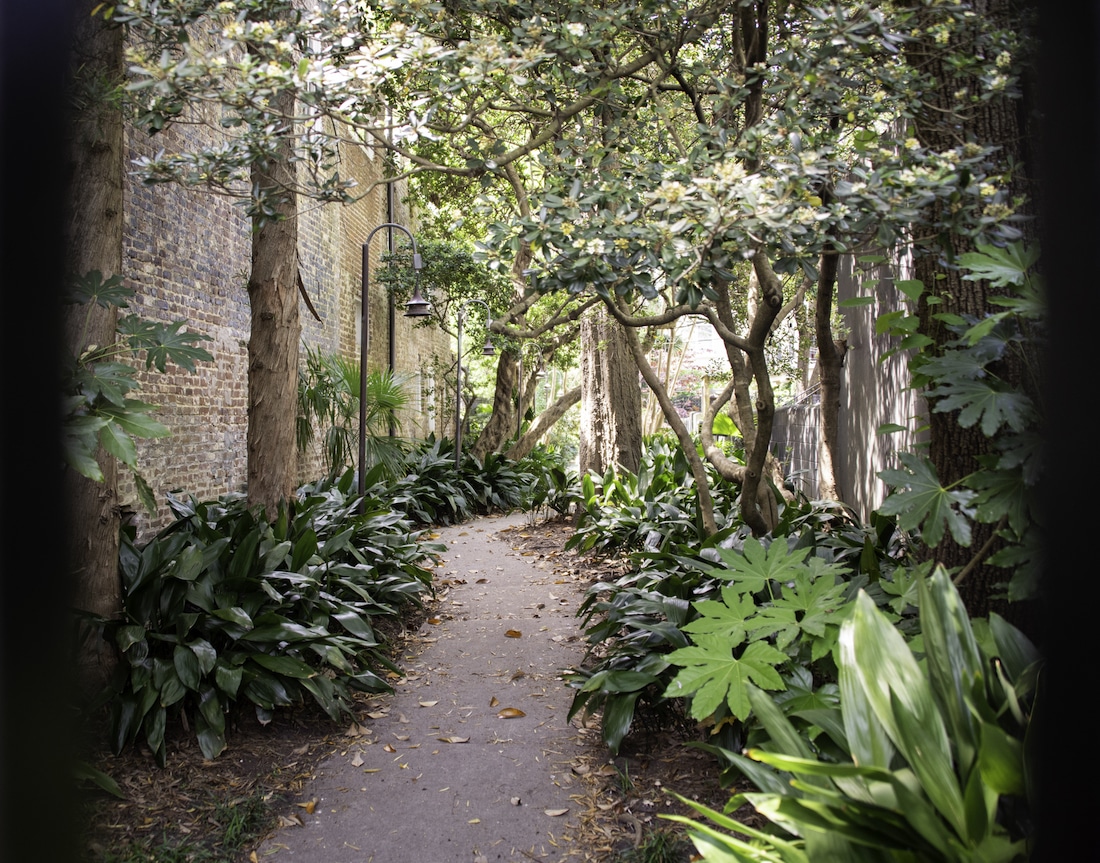
Charleston’s Most Captivating Hidden Gardens
Springtime invites you to step into Charleston’s hidden gardens thriving with history and blossoming flora. When the city’s flourishing landscape, rich soil and sub-tropical climate were discovered in the 1700s, famed European botanists saw an opportunity to plant the seeds of which would become some of the country’s most treasured flowers. From their influence, Charleston’s gardens became a gateway to plants like camellias, roses, tea olive, crepe myrtle, gardenias and azaleas, which have found their roots in the Holy City.
As you immerse yourself in Charleston’s hidden gardens, you’ll transport back in time to the European-influenced gardens of the city’s early beginnings. The moss-covered oak trees and sprawling flowers capture Charleston’s long-standing appreciation for ornate gardens.
Tucked away from the city’s lively shops and restaurants, the botanical vistas welcome a sense of inner harmony, allowing you to fully immerse in the Lowcountry’s natural beauty. For some, the landscapes draw creative inspiration, and for others, they offer a moment for contemplation.
Here are the most beautiful hidden gardens that you should visit:
Mrs. Whaley’s Garden – 58 Church Street
Known as the most private garden in America, Mrs. Whaley’s Garden is treasured by locals and visitors alike. Behind the Pre-Revolutionary home at 58 Church Street, Mrs. Whaley’s lush gardens are still thriving since they were designed in 1942. This oasis is open to the public Friday, Saturday and Sunday afternoons. Mrs. Whaley’s garden’s beauty has been featured in USA Today and on CBS Sunday morning and her New York Times bestselling book “Mrs. Whaley and Her Charleston Garden,” highlights reflections, gardening opinions and memories, in a conversational memoir.
The gardens were crafted by landscape artist Loutrel Briggs who is known for designing more than 100 small gardens in Charleston alone, many of which are still cherished today. Loutrel’s signature approach to landscape included a limited use of less than thirty indigenous plants like camellia, azalea, loquat, tea olive, wisteria, yellow jessamine, oleander and star jasmine. “Briggs’ limited plant palette not only helped to unify the garden’s design, but also provided a strong and continuous link with the past,” according to James Cothran in his book “Charleston Gardens and the Landscape Legacy of Loutrel Briggs.”
The Heart Garden – 91 Anston Street
One of Charleston’s most romantic private gardens is behind the St. John’s Reformed Episcopal Church. Designed as a permanent installation during the 1997 Spoleto Festival, The Heart Garden is cherished for its centerpiece topiary by Pearl Fryar. Peal, a widely acclaimed self-taught topiary artist, who donated it from his personal garden. Fryer also placed heart-shaped stones in the pathway. Another intimate detail is the wrought iron double heart fences made by local artist Philip Simmons, a legend in Charleston and beyond. The gardens are a hidden gem often used for wedding ceremonies or elopements where partners can celebrate their love in a serene environment.
The Gateway Walk – 5 Clifford Street
Take your time as you follow The Gateway Walk, a trail of graveyards and gardens full of secret beauty created by The Garden Club of Charleston in 1930. The historic walk begins at Archdale Street in the churchyard of St. John’s Lutheran Church and goes into the Unitarian churchyard next door. The ethereal gardens and old gravestones take you back in time to appreciate Charleston’s history and legends. The Unitarian grave markers are overtaken by vines, shrubs and wildflowers, aligned with the church’s beliefs about the web of creation. As you follow the trail, you’ll encounter a gate to a fern-lined pathway to King Street. Cross to the right side of the Charleston Library Society’s grand building where you’ll discover a green space behind it, perfect for picnics or reading. You can reach the spot as you pass through another iron gate, leading into the Gibbes Museum of Art’s formal gardens. Small tables offer a peaceful refuge from Charleston’s busy streets. Walk along the courtyard fountains through a wrought iron gate into Circular Congregational Church’s ancient cemetery brick path. You’ll approach another gate into St. Philip’s Graveyard and toward the big pink steeple, you’ll end the adventure at Church Street. Enjoy this private adventure through some of Holy City’s oldest gardens and churchyards.
Garden of the William C. Gatewood House – 21 Legare Street
Outside the antebellum home, this luxurious garden mixes Greek and Charleston styles to create a small paradise. Lush wisteria, crape myrtles and Sabal palmettos embellish the grounds around the shrubs that outline the private turquoise pool. This oasis designed by Loutrel Briggs who made distinctive gardens style in architectural settings popular throughout Charleston’s during 18th and 19th-century. The style has triumphed through the centuries, preserved by many who appreciate the prevailing gardens.
Built in 1843, the William C. Gatewood House is an 8,000-square-foot Greek Revival home, which was restored in 2009 by architect Gil Schafer upon receiving the AIA Merit Award for Historic Preservation by New York State. New York landscape designer Deborah Nevins contributed to the array of Southern plants throughout the pleasant gardens. The exquisite home and gardens are one of Charleston’s architectural treasures, worthy of a visit to witness the dedicated handiwork of the botanical artistry and charming historic mansion.